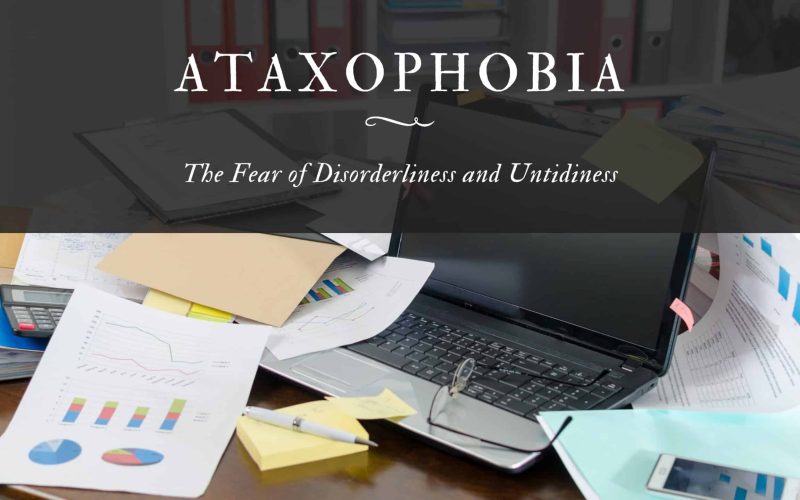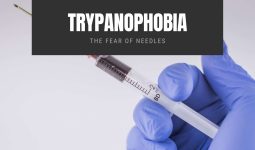Have you ever returned to your house and found it untidy? I’m sure you felt disgusted and irritated. If you did, that is a normal reaction that anyone would have, especially if they left their home clean.
However, some people have fear as an irrational response to this situation. These people are known to have a phobia called ataxophobia.
In simpler terms, ataxophobia can be defined as that irrational fear of disorder and untidiness.
A person who has this phobia usually experiences high levels of anxiety from just the mere thought of their house or their corners being untidy.
Being clean or wanting to be neat isn’t a wrong notion; in fact, it is often encouraged.
However, when you start to notice that untidiness causes an uneasy feeling of fear within you, then you are dealing with ataxophobia. Sometimes, their anxiety may be so intense that it can result in a full-blown panic attack.
Although it may not everyone who has ataxophobia that may develop anxiety and panic attacks, however, it is one of the most common symptoms among those who have this phobia.
A person who has developed panic attacks as a result of their uncontrolled anxiety will experience symptoms such as an increase in breathing rate, an increased heart rate, increased sweating, tremors and trembling, an increase in their blood pressure levels, and many more.
Just as it is with other phobias, people who have ataxophobia tend to avoid their fears as much as possible.
You may find a person who has ataxophobia arranging and rearranging objects in a particular place to ensure that no one object is out of place and that everything is exceptionally tidy.
Most times, people who are suffering from ataxophobia go to great lengths to ensure that they avoid disorderliness and untidiness in every way.
A person with ataxophobia is often seen as overly obsessed with how symmetrical and clean a place is. Hence, they become disturbed and worried if it becomes rowdy and untidy.
This excessive worrying and irrational obsession with putting everything in order and in its exact place is what causes their mental troubles.
Although a person dealing with ataxophobia can go to great lengths to avoid their fears, avoidance will only cause an increase in their symptoms.
According to experts, the more a person avoids his/her fears, the more their symptoms worsen over time.
This is because they usually end up rationalizing and justifying their worries to themselves and may even argue with others that they are doing okay, whereas the opposite is true.
Causes of Ataxophobia
The causes of Ataxophobia are not known. However, experts have seen that certain factors can contribute to the development of this anxiety disorder.
These factors include:
Genetics
If you have a family history of anxiety disorders or a history of mental illnesses, then there is a tendency for you to develop any phobia, including Ataxophobia.
It is important to note that if in your family there is a history of phobias, it doesn’t mean that you would develop the same phobia.
In other words, if any of your family members have suffered from any phobia, for example, levophobia (which is the fear of things on the left), you may not have levophobia. Instead, you can suffer from a different kind of phobia, such as Ataxophobia.
Environment
According to research, it takes an environmental event to trigger any phobia or social disorder. In other words, even though you may have the genetic predisposition to developing ataxophobia, often a trauma or a painful experience that may have occurred when you were a child can cause you to estate experiencing symptoms of Ataxophobia.
Brain Chemistry
The brain controls every activity that occurs in the body. It is the chief controller of your body. Once there is an alteration in the brain’s chemistry or electrochemical balance, it can result in different kinds of problems, including the development of Ataxophobia.
Symptoms of Ataxophobia
All phobias are supposed to be taken seriously and treated accordingly, or else they can limit a person’s day-to-day activities. In some phobias, they can cause severe anxiety and depression.
Hence, to help a person who has developed Ataxophobia, the primary key is teaching them how to manage their condition.
For them to properly engage in their daily activities, they must learn to control their thoughts, their anxiety as well as their fears of disorderliness and untidiness.
Sometimes, people who have ataxophobia not only try to avoid their fears, but they also try to avoid anything that makes them think of their fears- in this case, disorderliness and untidiness.
According to some psychologists, a person who has developed ataxophobia doesn’t necessarily have to be in a chaotic environment to begin to experience symptoms.
The mere thought of a disorganized place or even the thought of the phobia itself is enough to trigger a response. Our brains work in beautiful ways, and they can create imaginations.
Sometimes, a person who has ataxophobia can be in a clean place; however, the brain can start creating scenarios and thoughts, and these imaginations are enough to trigger a response in the form of symptoms.
However, it is essential to note that just as people vary and their phobias vary, the symptoms of a person experiencing ataxophobia also vary based on how severe their fears are.
Generally speaking, ataxophobia falls under a group known as specific phobias, and specific phobias are a type of anxiety disorder.
This means that a person who has ataxophobia will likely suffer from almost all of the physical and psychological symptoms. A person who has ataxophobia may experience the following symptoms:
Physical Symptoms
Most of the time, these physical symptoms occur without any warnings or prior signals.
People who have ataxophobia generally experience panic attacks, and it can be very distressing and frightening for the sufferers.
A person who suffers from panic attacks may experience one or mostly a combination of the following symptoms:
- Excessive sweating
- Trembling and tremors
- Chills or hot flushes
- Intense difficulties in breathing or shortness of breath.
- Choking sensations
- Tachycardia is often characterized by rapid heartbeats
- Tightness in your chest and often angina(pains in the chest).
- Disturbances in your stomach (often seen as butterflies in your tummy)
- Nausea and Vomiting
- Feelings of dizziness and fainting
- Pins and needle sensation or total numbness felt in the limbs
Other physical symptoms include;
- Sudden feelings of urgently needing to go to the toilet.
- The ringing of the ears.
- Confusion, lack of coordination, and disorientation.
- An increase in one’s blood pressure
- Hyperventilation
Psychological Symptoms
In severe cases, a person who is suffering from a panic attack can develop some psychological symptoms such as:
- Intense fear of losing control
- Intense fear of fainting
- Fear of sleeping and not waking up.
- Fear of sickness, harm, and diseases
- Sudden withdrawal from others
- Always feeling sad and distressed
- Feelings of hopelessness
- Feelings of confusion and disorientation.
- Anger and unexplainable mood swings
- Irritability
- Uncontrollable anxieties and worry.
In some rare cases, some patients can experience what is known as intertwined phobias. Intertwined phobias (complex phobias) usually occur when a person has two or more specific phobias.
For example, a person who developed levophobia and also went on to develop Ataxophobia can be said to have developed complex phobias.
Complex phobias can have devastatingly detrimental effects on the life of a patient.
It’s bad enough that one has to deal with the symptoms of one phobia. Can you imagine what dealing with two phobias at the same time will be like?
Because of how limiting complex phobias can be, they can hinder the patient from living a perfectly capable, regular, social, and personal lifestyle.
A complex phobia can trigger a chain of reactions that encompasses a majority of the symptoms listed above, and it can also cause severe depression in the life of the patient.
Treatment of Ataxophobia
People who have ataxophobia will hardly admit that they have an anxiety disorder, and as such, they keep on denying their symptoms.
Their denial and possible avoidance of the problem often cause this condition to persist.
Sometimes, it is impossible to avoid a disorderly or untidy environment; however, people who have ataxophobia need to learn to control their emotions and fears. It is crucial to seek professional help when you notice the symptoms.
It is also important to note that while it is possible to cure most phobias, there is no single treatment that is available for all of them, and it is completely guaranteed to work.
In other words, several forms of treatments can be used to treat ataxophobia. These treatments include;
Therapy
Most therapy starts from a particular place -talking. Talking therapies, which sometimes involve counseling, have been seen to be effective at treating most disorders, including ataxophobia.
Most counseling and therapy sessions are usually laid-back, physically non-intrusive treatments.
They typically involve you talking to a highly skilled professional who you know can listen and understand your thoughts, fears, and behavior.
There are different types of therapies, and each of them aims to do four major things:
- It helps you recognize the unhealthy patterns in your thoughts and behavior and find ways to change them.
- It enables you to resolve your complicated feelings and emotional behaviors or cope with them.
- It helps you understand yourself better and allows you to make sense of the things happening around you.
- Make you feel safe, knowing you can trust your doctor not to judge you.
Some of the therapies your psychologist may ask you to undertake include;
Cognitive Behavioral Therapy (CBT)
Cognitive Behavioural Therapy is usually based on the ideology that what we see and think always affects our behaviors and rationality.
According to experts who use CBT, anxiety, and distress are some of the major tools that can be used to distort a person’s perception of life and reality.
CBT seeks to identify whether a person’s thoughts are the correct depiction of reality and, if not, use specific strategies and plans to help the person change his/her wrong perception.
For example, a psychologist can treat a person who fears disorderliness and untidiness (ataxophobia) using CBT by first identifying that that fear is a false reality and, as such, seeking ways to change the patient’s perception.
Exposure Therapy
Exposure therapy is a process that usually follows after Cognitive Behavioural Therapy. Like its name, exposure therapy involves gradually exposing the patient to his or her fears.
This therapy is usually done in a controlled environment such that the patient is steadily eased into his or her fears.
According to scientists, the more a person is exposed to his or her phobia, the more the person starts to see why they don’t have to be afraid, and as such, they are then gradually eased into the thoughts of the fears.
Usually, ataxophobia introduces the patient to a sparsely disorganized place. Then, the patient’s reaction is graded, and as such, little by little, the person’s fear becomes extinguished.
The Use of Medications
When treating a phobia, your doctor may prescribe certain medications besides the therapy you are undertaking. However, the prescriptions of drugs are mostly dependent on how severe your anxiety is.
It is important to note that you must not take any of these drugs without your doctor’s prescription.
This is because, aside from the dangerous side effects of these medications, these drugs tend to become addictive.
The drugs your doctor may prescribe to you will, in most cases, fall under three categories namely;
- Beta-blockers
- Tranquilisers or sedatives
- Antidepressants(majority for those who are exhibiting the early signs of depression).
Self-help
Your psychologists can only do their best. However, if you want to feel normal again, you may have to engage in certain activities such as yoga, meditation, and so on.
Research has shown that yoga helps improve one’s brain chemistry, hence these two activities are often encouraged for those experiencing Ataxophobia.








